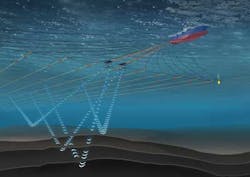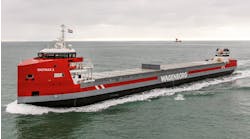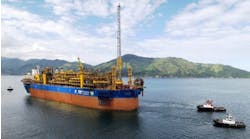Newer vessels look for work in frontier areas, particulary arctic and deepwater
The 2012 Seismic Vessel Survey found eight more vessels than in the previous year, but much of that is due to more and better reporting from the vessel operators. Subtracting the six existing but newly reported vessels gives an actual net increase of three year-over-year.
One trend that bears watching is that of vessels targeting the more difficult and hazardous regions of the globe, including the Arctic, and deeper water. Another is the increasing use of life-of-field seismic and ocean bottom node installations for added geophysical insight into reservoir management.
CGGVeritas says that deepwater played into its international operations last year, particularly in East and West Africa.
From 2006 to the start of this year, PGS Marine Geophysical saw demand for seismic growing by approximately 70% on a square kilometer basis. Of that, 3D is growing quicker than the overall market. This is because exploration is becoming more difficult, with deeper water, deeper targets, more complex geology, and harsher environments, and these all require greater data quality.
Polarcus looks at the market and expects to see exploration and production spending growing in the 15-20% range this year. As a result, it sees a fleet growth rise of about 3% net for 2012. The areas of strongest demand look to Polarcus to be northwestern Europe, the Arctic including Greenland, and deepwaters of the United States, Brazil, and West Africa.
DMNG is concentrating on building relationships with the oil companies working in the Eastern Hemisphere. Toward this end, ISO and Achilles accreditation have been achieved and with a full time HSE. Management team standards and practices are constantly reviewed and improved.
SMNG is exploring the Caspian with its 3DAkademik Nemchinov. At the conclusion of its Caspian contracts, the vessel to be transferred to the port of Baku for scheduled class repairs. Prior to starting an ongoing 3D survey for the Geo Energy Group on the Caspian Rakushechnoye structure, the vessel was upgraded in Poland with a new engine.
Getting into the Caspian was a project in itself. The only route went via the Don-Volga canal system with a maximum depth less than the draft ofAkademik Nemchinov. Major temporary alterations were done to prepare for the journey. The draft of the vessel was decreased from 5.6 to 3.5 m (18.4 to 11.4 ft). The masts and the seismic equipment were removed and the vessel put onto nine pontoons.
A couple of business moves were recorded in 2011. The decision to establish GeoRXT resulted from the strategic review by RXT management to realize value from its Brazilian operations. As part of the joint venture agreement, Georadar has invested $20 million in GeoRXT, and RXT has received a cash consideration of $10 million. GeoRXT is to focus initially on the anticipated demand for OBC seismic survey work in South America, Angola, and some Middle East locations. The RXT group will concentrate its activities in the North Sea, Gulf of Mexico, and West Africa where it has a track record for high resolution multi-component data.
High-quality data plays a key role in the optimal appraisal and development of discoveries and lowers the risk when drilling new wells. Similarly, high quality seismic is a key tool in the oil company's effort to arrest declining production from mature fields. High-definition 3D ocean bottom seismic (HDOBC) is becoming a strong competitor to towed streamer acquisition where high definition surveys for appraisal and production drilling are needed. RXT's HDOBC delivers data in these obstructed and challenging environments.
Late in 2011, SeaBird reached an agreement to sell its shares of Fugro OBN Technologies AS and Seabed Navigation Co. Ltd. to Fugro. This results in Fugro now holding 100% of both Fugro OBN and Seabed Nav.
BGP's recent R&D is focused on high-density seismic surveys, wide-azimuth acquisition, complex structure imaging, 3C/3D VSP, 3C/3D seismic, and stratigraphic reservoir studies. The company also has started to develop its own seismic recording systems.
BGP says it has the largest geophysical and geological R&D center in China. The research covers all of geophysics and geology, and is noted for high-order split migration and polynomial fitting.
On the offshore side, CGGVeritas offers pure-play geophysical services plus equipment through its Sercel products. Sercel has both land and marine geophysical equipment including integrated electronic recording systems, cables, land, ocean-bottom and borehole sensors, streamers, offshore seismic sources, and vibrators. Its geophysical services cover acquisition, data processing and imaging as well as reservoir management. Through Hampson-Russell Software & Services, CGGVeritas offers geophysical interpretation software and reservoir characterization.
CGGVeritas recently upgraded its seismic fleet of 19 vessels, retiring some older vessels and investing in two state-of-the-art 20-streamer Ulstein SX120 X-Bows. This modernization includes theOceanic Sirius delivered in October 2011. Vessel upgrade plans on schedule called for returning the Oceanic Phoenix and Endeavour to operations. The Champion went to the shipyard for a major upgrade.
China Oilfield Services recorded the delivery of a deepwater survey vessel in the latter half of 2011 and is adding a submarine cable team, which will be new business.
Global Geophysical has data acquisition, processing/analysis/interpretation, data library, proprietary recording technology, and microseismic services. It is featuring its Seismic Guided Earth Model to bring together geophysics and engineering in its Basin InSight program.
WesternGeco reported a survey fleet of 22 vessels in 2011, but chose not to be included this year. The counts in this report still include those 22 vessels, since they remain in the worldwide fleet.
Offshore Articles Archives
View Oil and Gas Articles on PennEnergy.com




